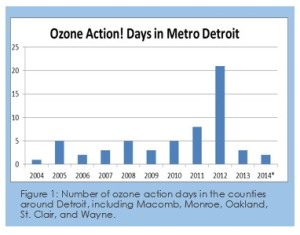Pollutant Fact Sheets
Ozone
WHAT IS OZONE?
Ozone (O3) is formed by chemical reactions between nitrogen oxides (NOx) and volatile organic compounds (VOCs) in the presence of sunlight, creating ground-level ozone. Ozone is a main part of “smog,” a haze that can persist for several days, decreasing visibility, and making it difficult to breathe. Ozone pollution has been a serious problem in many urban areas, including Detroit. High levels of ozone are harmful to health, and also damage plants and materials such as paint and rubber.
Ozone is also present high in the atmosphere, in the stratosphere where jet planes fly. Here, ozone is beneficial and needed because it removes harmful ultraviolet sunlight, keeping people safe from sunburns. Ground level ozone does not migrate to the stratosphere. The presence of ozone closer to the ground, where people live, can cause serious health problems.1-3
WHERE DOES OZONE COME FROM?
Ozone is not released directly into the air. It is made by chemicals (NOx and VOC). Industrial facilities, power plants, car and truck exhaust, gasoline vapors, and chemical solvents are important sources of NOx and VOC.1 These sources must be controlled to reduce ozone. In Detroit, emissions of VOCs appear to contribute the most to ozone. Therefore reducing VOC emissions will have the greatest impact on reducing ozone.2,3 Emission controls such as catalytic converters, vapor recovery, and product reformulations can help reduce VOC emissions.
HOW DOES OZONE AFFECT YOUR HEALTH?
Even at low levels, ozone can cause a number of respiratory and other health effects. Ozone increases your risk of the following:
- Difficulty breathing4
- Lung-related emergency room visits4
- Premature birth and smaller babies at birth5
- Brain damage and other birth defects6
- Possibility of early death4
- Hypertension during pregnancy7
- Lung diseases such as asthma and chronic obstructive pulmonary disease (COPD)4
IS DETROIT’S AIR HEALTHY?
 Urban areas, including Detroit, issue “ozone action days” when ozone levels are high. In Michigan, ozone is monitored by the Michigan Department of Environmental Quality (MDEQ). Currently, MDEQ and the US Environmental Protection Agency have designated Michigan to be “in attainment” with the National Ambient Air Quality Standard (NAAQS) for ozone.8 This means ozone levels do not exceed current standards. However, each year there are days when ozone levels are higher than what is considered healthy for some people, such as those with asthma.Ozone action days can result from higher temperatures. With climate change, ozone pollution may become increasingly challenging, see figure 1, there was an unusual number of hot days in 2012.
Urban areas, including Detroit, issue “ozone action days” when ozone levels are high. In Michigan, ozone is monitored by the Michigan Department of Environmental Quality (MDEQ). Currently, MDEQ and the US Environmental Protection Agency have designated Michigan to be “in attainment” with the National Ambient Air Quality Standard (NAAQS) for ozone.8 This means ozone levels do not exceed current standards. However, each year there are days when ozone levels are higher than what is considered healthy for some people, such as those with asthma.Ozone action days can result from higher temperatures. With climate change, ozone pollution may become increasingly challenging, see figure 1, there was an unusual number of hot days in 2012.
WHO IS MOST LIKELY TO BE AFFECTED?
Some groups are at risk of negative health effects due to higher levels of exposure to ozone pollution. These include those living near a major highway and those spending long hours outdoors. Other groups are at risk because they can experience stronger adverse health effects to ozone pollution. Children have the highest risk for developing health problems from ozone because their lungs are developing, and they spend more time outside when ozone levels can be highest.1 High ozone levels are also particularly unhealthy for people with existing respiratory disease, such as asthma. Other groups vulnerable to ozone pollution include older adults, people exercising or working outdoors, and people with cardiovascular disease.9
HOW TO REDUCE AND AVOID EXPOSURE TO OZONE
- Limit physical activity outdoors when the Air Quality Index (AQI) is unhealthy. See AirNow.gov
- Avoid scheduling strenuous outdoor activity in the afternoon and/or early evening, as ozone levels tend to be higher at these times.
- Conserve energy at home and in the office. Set your thermostat higher in the summer to use less electricity and reduce VOCs.
- Use products containing VOCs sparingly (for example, paints and solvents), and read labels for proper use and disposal.10
- Participate in your local utilities’ load-sharing, energy conservation and alternative energy programs.11
- Implement and enforce Southeast Michigan’s Council of Governments (SEMCOG’s) recommendation of incremental reductions of high-emitting polluting vehicles.12
- Increase the share of wind and solar energy using renewable portfolio standards or other policy actions.
- Upgrade poorly controlled emission sources such as power plants and major boilers, or phase them out.
- Increase transit options using efficient buses, bus rapid transit, and trains, which has the additional benefit of reducing congestion.
